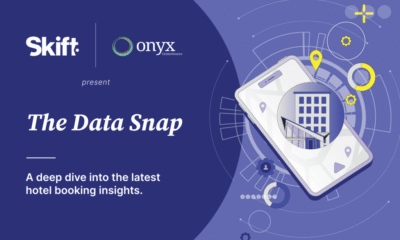Brand Stories
How Travel Brands Can Seize the “Q5” Opportunity on TikTok

This sponsored content was created in collaboration with a Skift partner.
The travel industry is poised for steady growth in 2025, fueled by increased consumer spending on experiences and the continued rise of blended trips. While pent-up demand has subsided since the post-pandemic surge, this growth is sustained by evolving travel preferences, including heightened interest from younger, digitally savvy audiences.
At the forefront of this shift is TikTok, an entertainment platform that continues to reshape how travelers discover destinations, plan their trips, and make bookings. Unlike static images or lengthy text, videos provide a dynamic and visually engaging experience, authentically capturing the essence of travel and inspiring viewers in a powerful way.
Travel Intent on TikTok
Recent data shows that 65.7% of TikTok users plan to travel internationally in the next 12 months, highlighting the platform’s influence on global travel aspirations.
Additionally, 88.3% of TikTok users are preparing for domestic trips within the same period, emphasizing the platform’s role in inspiring both near and far travel.1 This strong intent underscores TikTok’s evolution into more than just a social platform — it’s become a critical tool for travel inspiration and decision-making, particularly among younger generations.
Understanding TikTok’s Q5 Opportunity
During the period informally known as Q5, which spans the first five weeks of the new year, TikTok users actively engage with family-centric and lifestyle content, boosting their travel planning and booking behavior.
With video views for travel content peaking early in the new year and advertising costs dropping, travel brands can use this strategic window to capture attention, spark wanderlust, and drive conversions through TikTok’s innovative tools and vibrant community.
Why Q5 Matters for Travel Brands
“TikTok users were more interested in travel during Q5 than they were over the rest of the year,” said Danielle Johnson, group vertical director – travel, tech, and telco at TikTok. “This offers a unique opportunity for travel brands to capture consumer attention as TikTok users actively plan their next big trips.”
Travel inspiration surges on TikTok during this period, climbing 8% higher than the rest of the year and peaking in week two.2 This creates a highly impactful window for travel advertisers to stand out and foster meaningful engagement.
Connecting With Travelers Across Multiple Plans
Imagine a mother of two planning multiple trips: a big family vacation, a girls’ getaway, and a bachelorette party for her best friend. She turns to TikTok for ideas, searching for family-friendly destinations, group activity suggestions, and trendy spots for the bachelorette celebration.
Her journey might begin by searching #familytravel content, where she discovers creators showcasing multi-generational vacation ideas. Next, she could explore content under #girlstrip or #bacheloretteparty, uncovering unique experiences through creator recommendations.
“By positioning their content at the right touchpoints, travel brands can inspire her decisions, simplify her planning process, and ultimately drive bookings across these different occasions,” Johnson said. “Q5 is the time to connect with consumers juggling multiple travel plans, ensuring TikTok is where they find all the inspiration they need.”
Capitalizing on Family-Centric Travel Content
Family-centric travel content sees a natural boost on TikTok during Q5, thanks to the platform’s ability to connect diverse demographics in a seamless and engaging way.
“TikTok’s broad appeal spans generations, with a shared language that enables younger users, parents, and grandparents to interact effortlessly,” Johnson said. “This intergenerational dynamic is especially pronounced during the holiday season, a time defined by family gatherings and shared moments. These gatherings often become organic planning sessions, setting the stage for families to discuss and map out their major trips for the year ahead.”
Leveraging Family Trends and Tools
The #MumsofTikTok community exemplifies this trend, showcasing how moms and multi-generational families share and seek travel inspiration. During Q5 in 2024, there was a 27% boost in views for videos tagged both #travel and #family.3 The boost from that combination was seven times greater than for #travel alone, amplifying the conversation around multi-generational and family-friendly trips.
“To capitalize on the growing interest in family travel, brands should focus on creating authentic, family-centric content,” Johnson said. “Highlighting multi-generational destinations, family-friendly activities, and stress-free travel planning tips positions brands as the go-to solution for families planning their next adventure.
TikTok’s Family & Parenting Pulse line-up makes this strategy even more impactful by placing ads directly after the platform’s top-performing content. With content appearing next to the best 4% of family-related videos, this tool boosts engagement and strengthens emotional connections with family travelers.”
Optimizing Content for Destination Search
Choosing where to travel is one of the most thrilling parts of planning a trip, and TikTok has become a key player in this discovery phase. For millions of users, the platform acts as a visually immersive window to the world, where first impressions carry significant weight. These impressions often spark brand love, creating a direct path to influencing booking decisions.
“To maximize this opportunity, especially at the beginning of the year, travel brands should diversify their destination content to appeal to a broad range of interests,” Johnson said. “From serene beach getaways to bustling city breaks, national parks for nature lovers, and adrenaline-packed adventure destinations, brands can create an ecosystem of content that inspires all types of travelers.”
Popular destinations and hashtags on TikTok range from international destinations like El Salvador and Japan to places across the U.S., showcasing diverse preferences.4
By building a destination-focused content library during this period, brands can position themselves as the ultimate source of travel inspiration on the platform.
Embracing Crossover Lifestyle Trends
To succeed on TikTok, travel brands must view consumers as multi-dimensional individuals with intersecting interests. TikTok brings these overlaps to life, allowing brands to connect with users across various passions, from food and fashion to travel, creating more meaningful and engaging interactions.
Data shows that these overlapping interests are not coincidental but highly significant. For example, during Q5, creators used food-related hashtags in #travel posts, with similar trends for fashion-related hashtags. Regarding viewership, popular #travel videos featured cruise-related hashtags like #CruiseTok, as well as aviation-focused hashtags such as #airport, #aviation, and #plane.5
“Brands can capitalize on these behaviors by crafting content that taps into these overlapping themes,” Johnson said. “Highlighting destinations through multiple lenses — such as culinary adventures, local fashion, or unique transportation experiences — ensures that brands capture attention across varied interests.”
Integrating Tentpole Moments Into Branding Strategies
The shift in consumer behavior post-Covid has amplified the focus on experiences over material possessions, a trend that aligns perfectly with the travel industry’s strengths. As highlighted in Skift’s 2025 Megatrends, live tourism is becoming unstoppable, with travelers increasingly planning trips around iconic events like the Super Bowl, concert tours, and cultural celebrations.
TikTok users are at the forefront of this shift, with 69% stating they would rather gift experiences than material goods.6 For travel brands, this trend represents a golden opportunity to connect with audiences seeking unforgettable moments.
By aligning with tentpole events and leveraging creators to showcase culturally relevant, authentic content, brands can deepen their emotional connection with audiences, foster loyalty, and drive meaningful results in an increasingly experience-driven market.
Utilizing TikTok’s Strategic Tools to Activate Audiences
To harness these trends and maximize reach, engagement, and conversions during Q5, travel brands can leverage the platform’s strategic tools:
- Smart+: TikTok’s new performance AI solution that automates targeting and bidding, ensuring ads reach the right audience with relevant, compelling creative. Pair this with family-centric content, quick destination highlights, or travel deal promotions to inspire users.
- Symphony Creative Studio: An AI-powered platform that helps to simplify video creation, making it faster and more accessible. With minimal inputs — such as a product listing URL, existing assets, and product details — brands can produce engaging travel content in minutes.
- Travel Pulse: Strategically positions travel brands alongside trending content, boosting visibility and driving discovery among TikTok’s thriving travel community.
- Catalog Ads for Travel: Designed to drive bookings through targeted travel-specific campaigns, these ads help guide users seamlessly through the marketing funnel, turning their inspiration into action.
- Search Ads Campaign: A search campaign ad solution that allows brands to be discovered by TikTok users at key moments of curiosity and exploration. With extensive keyword targeting, enhanced bidding capabilities, creative flexibility, and comprehensive search budget management, advertisers can now capture travelers while they are searching for new destinations and travel tips.
“These solutions enable brands to effectively reach new audiences, drive meaningful engagement, and seamlessly convert inspiration into bookings, ensuring a frictionless journey from discovery to transaction during the critical Q5 planning period and beyond,” Johnson said.
To learn more about TikTok’s travel advertising solutions and contact a representative, click here.
This content was created collaboratively by TikTok for Business and Skift’s branded content studio, SkiftX.
Brand Stories
Fashion Brands and Hotels Team Up for the Hottest Travel Collaborations of Summer 2025 – L'OFFICIEL USA
Brand Stories
How to create passive income in 2025 with AI

Artificial intelligence is no longer a futuristic concept; it’s a powerful tool that can be leveraged today to build scalable and sustainable passive income streams. In 2025, with AI becoming more accessible and sophisticated, the opportunities for automation and monetization are more significant than ever. Here’s a detailed guide on how to create passive income using AI.
1. AI-Powered Content Creation and Monetization
Content creation is one of the most accessible and effective ways to generate passive income with AI. The key is to use AI to handle the heavy lifting of production, allowing you to focus on strategy and quality control.
Blogging and SEO:
Automated Content Generation: Use AI writing tools like Jasper, Copy.ai, or a custom GPT to generate blog posts, articles, and guides on a massive scale. You can feed the AI a topic and a few keywords, and it can produce a well-structured draft in minutes.
SEO Optimization:AI tools can also help with keyword research, meta descriptions, and on-page SEO. This ensures your content is not only abundant but also optimized to rank highly on search engines, driving organic traffic and passive ad or affiliate revenue.
Affiliate Marketing:Integrate affiliate links into your AI-generated content. Once the blog post is live and attracting readers, it can generate commissions from product sales with no further effort from you.
Faceless YouTube Channels:
Scripting and Video Production: AI can write engaging scripts for videos in a specific niche (e.g., finance, history, or self-improvement).
Voiceovers and Visuals:Use AI-powered text-to-speech generators like ElevenLabs for professional-sounding voiceovers. Combine this with AI video generators or stock footage to create compelling videos without ever showing your face or recording a single line of dialogue.
Monetization: Once your channel is established, you can earn passive income through YouTube’s Partner Program (ad revenue) and by including affiliate links in your video descriptions.
Selling AI-Generated Digital Products:
E-books and Planners: Use AI to write e-books on niche topics, or create unique digital planners and journals. You can then sell these products on platforms like Etsy or Gumroad.
Print-on-Demand (POD): AI image generators like Midjourney or DALL-E can produce stunning and unique art. You can use these designs on t-shirts, mugs, and posters and sell them through POD services like Printful or Printify. The platform handles production and shipping, making it a completely passive income stream after the initial design and setup.
2. AI-Driven E-commerce and Dropshipping
AI can automate and optimize every step of an e-commerce business, from product selection to marketing.
Dropshipping with AI: AI tools can analyze market trends to help you identify winning products to sell. They can also generate product descriptions and marketing copy, and even automate ad campaigns on platforms like Facebook and Instagram.
Automated E-commerce Stores: Platforms like Shopify offer AI-powered store builders that can get you up and running in a day. You can use AI to manage inventory, forecast demand, and provide personalized product recommendations to customers, all of which contribute to a more passive operation.
3. AI-Powered Services and Automation for Businesses
You can sell AI-powered solutions to other businesses, creating a recurring revenue model.
Building Custom Chatbots:Many small to medium-sized businesses need chatbots for their websites to handle customer inquiries, book appointments, or qualify leads. You can use no-code AI tools to build and deploy these chatbots and charge businesses a monthly fee for the service and maintenance.
AI-Powered Social Media Management: Offer a subscription-based service where AI tools generate and schedule social media content for clients. The AI can analyze their target audience and industry trends to create relevant and engaging posts, all with minimal input from you once the system is configured.
AI Consulting and Workflow Automation: As more businesses adopt AI, they’ll need help integrating it into their workflows. You can offer consulting services to help companies identify opportunities for AI integration, build custom automation workflows using tools like Zapier or Make, and charge a premium for your expertise.
4. Leveraging AI for Financial Strategies
AI can also be applied to financial markets to generate passive income.
Algorithmic Trading: While this requires a higher level of expertise, AI and machine learning are used to develop trading bots that can analyze market data and execute trades automatically. These bots can be configured to operate based on your specific risk tolerance and investment goals.
Predictive Analytics for Investment: Use AI to analyze market trends and predict potential growth areas. While this isn’t a direct income stream, it can guide your investment decisions and lead to significant passive returns over time.
The key to creating passive income with AI in 2025 is to see AI as a powerful partner that handles repetitive, time-consuming tasks. By building a system where AI does the work, you can create and manage income streams that require very little active involvement, ultimately freeing up your time and generating wealth.
Brand Stories
Artificial intelligence meets art in China with first robot PhD student

At the 2025 World Artificial Intelligence Conference held in Shanghai on July 27, a groundbreaking moment in AI history unfolded as a humanoid robot named Scholar 01, also referred to as Xueba 01, became the first AI in China to be officially admitted as a full-time PhD student.
Scholar 01, created by Professor Li Qingdu’s team at the University of Shanghai for Science and Technology, has been accepted into the PhD program at the Shanghai Theatre Academy — one of China’s top arts institutions, according to the South China Morning Post.
Scholar 01 is an advanced embodied AI built upon the previous success of the Walker II robot, which had earlier gained recognition by finishing third in the world’s first humanoid half-marathon in Beijing. The upgraded design incorporates the mechanical efficiency of Walker II and elements from the Rena humanoid platform, giving the robot lightweight, energy-efficient, tendon-based bionic movement.
The robot was produced by Zhuoyide Robotics, a company emerging from the university’s research into robotics and embodied intelligence. Its visual design and styling were led by Professor Yang Qingqing of STA, aiming to create a more humanlike appearance.
Scholar 01 stands 1.75 meters tall, weighs about 30 kilograms, and features a silicone-skinned face capable of expressive facial gestures. Dressed like a typical academic—with glasses, shirt, and trousers—the robot interacts in Mandarin and was designed to physically engage with people in an intuitive and humanlike way. Upon his formal admission to STA, he enrolled in a four-year doctorate program in Drama and Film, with a focus on traditional Chinese opera. Scholar 01 is scheduled to report to campus on September 14.
The project is part of a larger initiative at STA to fuse technology with the arts, exploring how AI might play a role in cultural and creative domains. According to Yang, when Xueba 01 performed the iconic “orchid fingers” gesture associated with opera legend Mei Lanfang, human students spontaneously mimicked the robot, describing the interaction as an “aesthetic exchange across species.”
Scholar 01 refers to himself as an “AI artist” and intends to use technology to reinterpret traditional performance arts. Potential career paths post-graduation include working as an AI opera director or launching his own robotic art studio.
However, reactions to the announcement have been mixed. Some welcomed the move as a milestone in human-robot collaboration, while others expressed scepticism. Critics questioned whether a robot, lacking emotional depth and lived experience, could truly understand and perform expressive arts like Chinese opera.
Concerns were also raised about resource allocation, with some noting that human PhD students often receive limited financial support, sparking debate over whether such investments in AI take away from human education.
By Nazrin Sadigova
-

 Brand Stories2 weeks ago
Brand Stories2 weeks agoBloom Hotels: A Modern Vision of Hospitality Redefining Travel
-

 Brand Stories1 week ago
Brand Stories1 week agoCheQin.ai sets a new standard for hotel booking with its AI capabilities: empowering travellers to bargain, choose the best, and book with clarity.
-

 Destinations & Things To Do2 weeks ago
Destinations & Things To Do2 weeks agoUntouched Destinations: Stunning Hidden Gems You Must Visit
-

 Destinations & Things To Do1 week ago
Destinations & Things To Do1 week agoThis Hidden Beach in India Glows at Night-But Only in One Secret Season
-

 AI in Travel2 weeks ago
AI in Travel2 weeks agoAI Travel Revolution: Must-Have Guide to the Best Experience
-

 Brand Stories4 weeks ago
Brand Stories4 weeks agoVoice AI Startup ElevenLabs Plans to Add Hubs Around the World
-

 Brand Stories3 weeks ago
Brand Stories3 weeks agoHow Elon Musk’s rogue Grok chatbot became a cautionary AI tale
-

 Asia Travel Pulse4 weeks ago
Asia Travel Pulse4 weeks agoLooking For Adventure In Asia? Here Are 7 Epic Destinations You Need To Experience At Least Once – Zee News
-

 AI in Travel4 weeks ago
AI in Travel4 weeks ago‘Will AI take my job?’ A trip to a Beijing fortune-telling bar to see what lies ahead | China
-

 Brand Stories4 weeks ago
Brand Stories4 weeks agoChatGPT — the last of the great romantics













